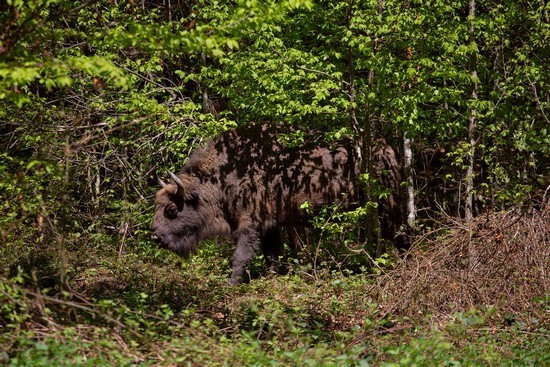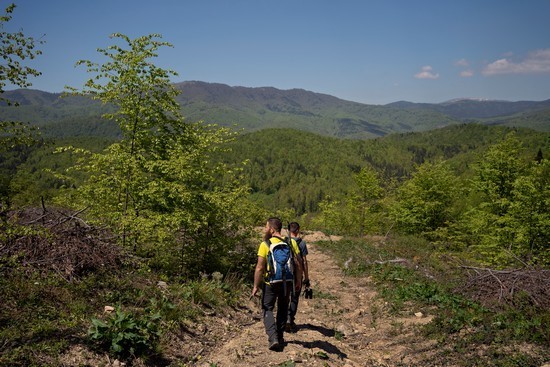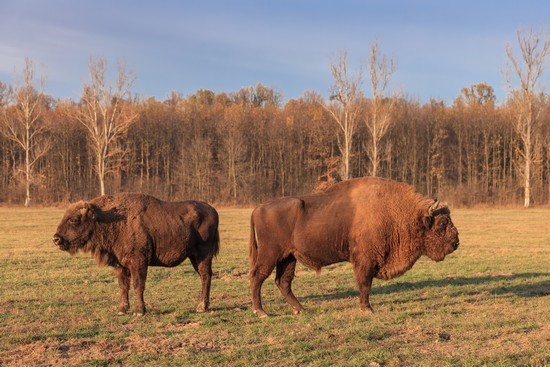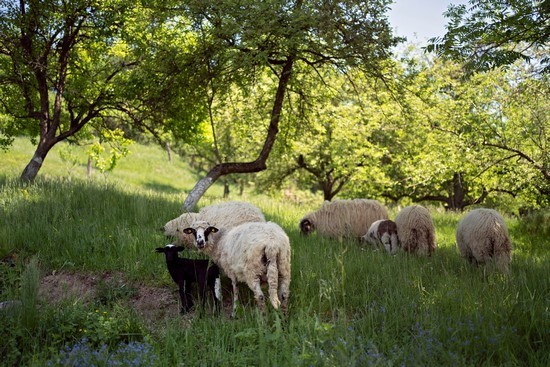On safari in the Transylvanian Alps, where bison roam once more
New York Times
last updated: Jun 02,2022

It was not a situation in which I ever expected to find myself: crouched in a
Romanian meadow at the edge of a primeval forest, listening for bison
footsteps. “Sit spot” is what our guide called it. You spread out and
triangulate the area where you know the bison have recently been, listening
over the heathery din of insects, birds, and wind-rustled flora for auditory
traces of Europe’s largest land animal, which, until recently, has not been
seen in these parts for hundreds of years. I heard something moving behind me,
the crunch of fallen foliage, turning just in time to see a flash of what I
knew by then was most likely a red deer.اضافة اعلان
It was my second day tracking bison in Romania’s Tarcu Mountains, so far without a glimpse. But I knew by now how to read their movements from a tangle of hoofprints. I knew where to find the abandoned orchards they favor, vacated when local farmers could no longer compete with the low-cost German supermarkets that colonized the market after Romania joined the EU in 2007.

Now the orchards were overgrown and reclaimed — by the bears who come out at night to plunder the fruit trees and the bison who devour their branches, leaving rain-filled prints for yellow-bellied toads, and plowing corridors through thick vegetation for wild boar, badgers and other small herbivores to expand their terrain, be fruitful and multiply.
I was witnessing a process known as rewilding, a progressive approach to conservation that aims to restore ecosystems by stripping away human interventions, like dams and dikes, in places that have been depopulated and economically marginalized. Essential to rewilding is the reintroduction of “keystone species” like wolves, vultures and bison, animals that have an outsize influence on their habitat, significantly reshaping the landscape and promoting biodiversity through grazing, spreading seeds and predatory population control.

Over the past nine years, more than 60 bison have been released from captivity in this part of the Southern Carpathians, also called the Transylvanian Alps, a densely forested mountain range in southern Romania that holds some of the highest concentrations of animal and plant species on the continent. The Southern Carpathians are one of nine “rewilding landscapes” managed by Rewilding Europe, a nonprofit that was founded in the Netherlands in 2011 by two Dutchmen, a Swede, and a Scot.
Despite criticism (most notably after an early experiment at a Dutch reserve called Oostvaardersplassen developed into a wasteland of animal corpses), the rewilding movement has overall been a huge success. Elk, wolves, bison, and bears are once again growing in numbers across the continent, enhancing biodiversity and carbon capture. Last year, the UN acknowledged rewilding as one of several recommended methods of ecosystem restoration.

Setting off on a European safari
Five years ago, the idea of a European safari might have seemed like a long shot, but in a world shaken by COVID and threatened by climate change, the prospect of a wilderness experience with a positive environmental impact in a remote, beautiful part of the world in need of tourism holds obvious appeal. That was my feeling, at least, as I set off in September with my partner for a bison tracking safari in the Southern Carpathians.
I traveled by train to Romania from our home in Berlin, stopping overnight in Budapest before continuing to Timișoara, a culturally vibrant city in western Transylvania with a profoundly unpleasant Soviet train station. After waiting there for more than an hour for our driver, who eventually showed up speaking not a word of English, hectically pantomiming for us to follow him to his car parked half a mile away, I got a sense of why the agent from the European Safari Company kept warning me that, in contrast to some of their other destinations, this part of Romania “is still not really set up for international tourism.” But the train station was a distant memory by the time we arrived two hours later at a 100-year-old farmhouse in the wooded mountain village of Sat Bătrân.

Waiting for us in the grassy courtyard was Matei Miculescu, a 30-year-old local guide and bison ranger who would accompany us for the rest of the trip. Soft-spoken, with closely cropped black hair and a wiry physique, Matei grew up on a farm in a nearby village. His parents once supported themselves through farming, but like almost everyone in the area, Matei explained, they now travel for seasonal work and farm only for subsistence to offset the price of groceries. Matei lives with his wife, their small child, and his grandmother. His father works for the railroad, and his mother spends most of the year in Austria caring for the elderly.
There was a lot of local skepticism when the rewilding program first came here in 2014, Matei said. But opinion shifted once the ecotourism project began a few years later. “We released these bison into the wild, and the locals accepted them living on their land basically, and now we have to give them something back,” Matei said, explaining that every aspect of our trip, from meals to transports to the family renting out the guesthouse, would be handled by villagers.

Early the next morning, Matei and a driver picked us up in a huge, battered pickup and we drove up to the base camp, an idyllic hillside farmstead scattered with blossoming apple trees and camping tents, where we were greeted by about 100 sheep and a handful of enthusiastic sheepdogs. We dropped our bags while Matei chatted with the shepherd, a youngish, tough-looking chain-smoker in waders leaning on a wooden walking stick. Then we headed into the mountains.
The forest closed in around us, huge beech trees and pines, many of them hundreds of years old. The Carpathians encompass the largest area of unbroken forest on the continent, as well as the highest concentrations of brown bears, wolves and lynxes and more than a third of all European plant species.
For thousands of years, the European bison, a close relative of the American bison, roamed these mountains — part of a habitat that extended from southern France to the Volga River and the Caucasus. Its ancestor, the steppe bison, appears in cave paintings dating back more than 35,000 years.

As human populations expanded and cut down forests, the bison’s range decreased, and by the turn of the century it had been hunted to near extinction. The last wild European bison was killed by poachers in the Russian Caucasus in 1927. By then, fewer than 50 remained, all held in zoos. Projects aimed at saving the bison began almost immediately in Germany and Poland, where the first bison reintroduction took place in the Białowieża Forest in 1952. Breeding programs and reintroductions continued through the rest of the century, and by 2010, there were more than 2,000 free-roaming bison in Europe.
But no wild bison had been seen in the Southern Carpathians for more than 200 years when the rewilding initiative arrived in 2014. “They were thought of almost as mythical creatures,” said Matei, who has worked as a bison ranger since the project began. With support from the EU and the Dutch Postcode Lottery, Rewilding Europe and the World Wildlife Fund began shipping in bison to release from captivity. In the beginning they purchased them from nature reserves and zoos, but few of the bison from zoos survived.
“The stress was too much for them, of finding enough food, living with the herd,” Matei said. “So we said OK, we will not take bison from zoos anymore, only large reserves.” After that, they were more successful, and the population has grown to upwards of 100, with more than 38 calves born in the Southern Carpathians.

We were visiting in the peak of mating season, Matei explained in a whisper as we made our way up a steep mountain pass. Like elephants and lions, bison are matriarchal, living in large, mostly female herds led by one “alpha female.” Weighing up to a ton, mature males live alone or in pairs, approaching the herd only during mating season. The males then fight for dominance, butting heads in a brutal face-off that can end in death. Only the winner stays with the herd.
We followed Matei up through dense forest and meadows of alpine grass, rock jasmine, silver thistle and edelweiss as he pointed out ways the reintroduced bison have impacted the environment: creating corridors through thick undergrowth and eating the bark off young trees, which allows meadows to form. Matei pointed out a “dust bath” where bison had wallowed in the dirt, a process that cleans and protects their fur, and creates surfaces for insects and reptiles to sunbathe and lay eggs.
“Bison being the biggest mammal in Europe, of course there’s a huge impact, much more than we can see,” said Matei as we watched yellow-bellied toads swimming in bison hoofprints filled with rainwater. “We see lots of small things happening, like the birds collecting their fur and putting it in their nests because it’s much better insulated.”
These nature tours are just a small part of Matei’s job, the bulk of which consists of tracking bison, taking samples for a DNA project in collaboration with a German university, reading GPS data and reviewing footage from cameras hidden throughout the woods. But the most important task seems to be inspecting their dung. We certainly did a lot of it — to the point where I began to ask myself whether I’d traveled across Europe to walk around in the woods looking for feces.
An old way of life
In the afternoon, we crossed barefoot through an ice-cold stream and ascended on the other side of a ravine, hiking until we reached a summit and looked for bison on the opposite massif.
We decided to set off before dawn the next day. We followed the route from the day before, but pushed farther, tracking bison prints and other traces until we entered an older part of the forest. There were no trails, and the three of us spread out, lost in our own private worlds.
As the forest thinned, I saw Matei coming toward me from up ahead, gesturing wildly and signaling to be quiet. “It’s the herd!” he shout-whispered, motioning toward a clearing. Unnecessarily, we dropped to the ground and crawled to the edge of the meadow, where we could hide in the brush and see down into the clearing.
Not 20 feet in front of us, a herd of around 15 bison, shaggy and magnificent, grazed on tall bushes in the meadow. One of them — probably the alpha — clocked us immediately. She stood motionless, staring directly at us as the others, all female except for a calf and two young males, continued to graze. We hid there in the bushes watching them, enrapt for the better part of an hour. Finally, the alpha called out in a deep bellow and the herd stampeded away in a cloud of dust, back into the woods that were once again theirs.
Read more Travel
Jordan News
It was my second day tracking bison in Romania’s Tarcu Mountains, so far without a glimpse. But I knew by now how to read their movements from a tangle of hoofprints. I knew where to find the abandoned orchards they favor, vacated when local farmers could no longer compete with the low-cost German supermarkets that colonized the market after Romania joined the EU in 2007.

Now the orchards were overgrown and reclaimed — by the bears who come out at night to plunder the fruit trees and the bison who devour their branches, leaving rain-filled prints for yellow-bellied toads, and plowing corridors through thick vegetation for wild boar, badgers and other small herbivores to expand their terrain, be fruitful and multiply.
I was witnessing a process known as rewilding, a progressive approach to conservation that aims to restore ecosystems by stripping away human interventions, like dams and dikes, in places that have been depopulated and economically marginalized. Essential to rewilding is the reintroduction of “keystone species” like wolves, vultures and bison, animals that have an outsize influence on their habitat, significantly reshaping the landscape and promoting biodiversity through grazing, spreading seeds and predatory population control.

Over the past nine years, more than 60 bison have been released from captivity in this part of the Southern Carpathians, also called the Transylvanian Alps, a densely forested mountain range in southern Romania that holds some of the highest concentrations of animal and plant species on the continent. The Southern Carpathians are one of nine “rewilding landscapes” managed by Rewilding Europe, a nonprofit that was founded in the Netherlands in 2011 by two Dutchmen, a Swede, and a Scot.
Despite criticism (most notably after an early experiment at a Dutch reserve called Oostvaardersplassen developed into a wasteland of animal corpses), the rewilding movement has overall been a huge success. Elk, wolves, bison, and bears are once again growing in numbers across the continent, enhancing biodiversity and carbon capture. Last year, the UN acknowledged rewilding as one of several recommended methods of ecosystem restoration.

Setting off on a European safari
Five years ago, the idea of a European safari might have seemed like a long shot, but in a world shaken by COVID and threatened by climate change, the prospect of a wilderness experience with a positive environmental impact in a remote, beautiful part of the world in need of tourism holds obvious appeal. That was my feeling, at least, as I set off in September with my partner for a bison tracking safari in the Southern Carpathians.
I traveled by train to Romania from our home in Berlin, stopping overnight in Budapest before continuing to Timișoara, a culturally vibrant city in western Transylvania with a profoundly unpleasant Soviet train station. After waiting there for more than an hour for our driver, who eventually showed up speaking not a word of English, hectically pantomiming for us to follow him to his car parked half a mile away, I got a sense of why the agent from the European Safari Company kept warning me that, in contrast to some of their other destinations, this part of Romania “is still not really set up for international tourism.” But the train station was a distant memory by the time we arrived two hours later at a 100-year-old farmhouse in the wooded mountain village of Sat Bătrân.

Waiting for us in the grassy courtyard was Matei Miculescu, a 30-year-old local guide and bison ranger who would accompany us for the rest of the trip. Soft-spoken, with closely cropped black hair and a wiry physique, Matei grew up on a farm in a nearby village. His parents once supported themselves through farming, but like almost everyone in the area, Matei explained, they now travel for seasonal work and farm only for subsistence to offset the price of groceries. Matei lives with his wife, their small child, and his grandmother. His father works for the railroad, and his mother spends most of the year in Austria caring for the elderly.
There was a lot of local skepticism when the rewilding program first came here in 2014, Matei said. But opinion shifted once the ecotourism project began a few years later. “We released these bison into the wild, and the locals accepted them living on their land basically, and now we have to give them something back,” Matei said, explaining that every aspect of our trip, from meals to transports to the family renting out the guesthouse, would be handled by villagers.

Early the next morning, Matei and a driver picked us up in a huge, battered pickup and we drove up to the base camp, an idyllic hillside farmstead scattered with blossoming apple trees and camping tents, where we were greeted by about 100 sheep and a handful of enthusiastic sheepdogs. We dropped our bags while Matei chatted with the shepherd, a youngish, tough-looking chain-smoker in waders leaning on a wooden walking stick. Then we headed into the mountains.
The forest closed in around us, huge beech trees and pines, many of them hundreds of years old. The Carpathians encompass the largest area of unbroken forest on the continent, as well as the highest concentrations of brown bears, wolves and lynxes and more than a third of all European plant species.
For thousands of years, the European bison, a close relative of the American bison, roamed these mountains — part of a habitat that extended from southern France to the Volga River and the Caucasus. Its ancestor, the steppe bison, appears in cave paintings dating back more than 35,000 years.

As human populations expanded and cut down forests, the bison’s range decreased, and by the turn of the century it had been hunted to near extinction. The last wild European bison was killed by poachers in the Russian Caucasus in 1927. By then, fewer than 50 remained, all held in zoos. Projects aimed at saving the bison began almost immediately in Germany and Poland, where the first bison reintroduction took place in the Białowieża Forest in 1952. Breeding programs and reintroductions continued through the rest of the century, and by 2010, there were more than 2,000 free-roaming bison in Europe.
But no wild bison had been seen in the Southern Carpathians for more than 200 years when the rewilding initiative arrived in 2014. “They were thought of almost as mythical creatures,” said Matei, who has worked as a bison ranger since the project began. With support from the EU and the Dutch Postcode Lottery, Rewilding Europe and the World Wildlife Fund began shipping in bison to release from captivity. In the beginning they purchased them from nature reserves and zoos, but few of the bison from zoos survived.
“The stress was too much for them, of finding enough food, living with the herd,” Matei said. “So we said OK, we will not take bison from zoos anymore, only large reserves.” After that, they were more successful, and the population has grown to upwards of 100, with more than 38 calves born in the Southern Carpathians.

We were visiting in the peak of mating season, Matei explained in a whisper as we made our way up a steep mountain pass. Like elephants and lions, bison are matriarchal, living in large, mostly female herds led by one “alpha female.” Weighing up to a ton, mature males live alone or in pairs, approaching the herd only during mating season. The males then fight for dominance, butting heads in a brutal face-off that can end in death. Only the winner stays with the herd.
We followed Matei up through dense forest and meadows of alpine grass, rock jasmine, silver thistle and edelweiss as he pointed out ways the reintroduced bison have impacted the environment: creating corridors through thick undergrowth and eating the bark off young trees, which allows meadows to form. Matei pointed out a “dust bath” where bison had wallowed in the dirt, a process that cleans and protects their fur, and creates surfaces for insects and reptiles to sunbathe and lay eggs.
“Bison being the biggest mammal in Europe, of course there’s a huge impact, much more than we can see,” said Matei as we watched yellow-bellied toads swimming in bison hoofprints filled with rainwater. “We see lots of small things happening, like the birds collecting their fur and putting it in their nests because it’s much better insulated.”
These nature tours are just a small part of Matei’s job, the bulk of which consists of tracking bison, taking samples for a DNA project in collaboration with a German university, reading GPS data and reviewing footage from cameras hidden throughout the woods. But the most important task seems to be inspecting their dung. We certainly did a lot of it — to the point where I began to ask myself whether I’d traveled across Europe to walk around in the woods looking for feces.
An old way of life
In the afternoon, we crossed barefoot through an ice-cold stream and ascended on the other side of a ravine, hiking until we reached a summit and looked for bison on the opposite massif.
We decided to set off before dawn the next day. We followed the route from the day before, but pushed farther, tracking bison prints and other traces until we entered an older part of the forest. There were no trails, and the three of us spread out, lost in our own private worlds.
As the forest thinned, I saw Matei coming toward me from up ahead, gesturing wildly and signaling to be quiet. “It’s the herd!” he shout-whispered, motioning toward a clearing. Unnecessarily, we dropped to the ground and crawled to the edge of the meadow, where we could hide in the brush and see down into the clearing.
Not 20 feet in front of us, a herd of around 15 bison, shaggy and magnificent, grazed on tall bushes in the meadow. One of them — probably the alpha — clocked us immediately. She stood motionless, staring directly at us as the others, all female except for a calf and two young males, continued to graze. We hid there in the bushes watching them, enrapt for the better part of an hour. Finally, the alpha called out in a deep bellow and the herd stampeded away in a cloud of dust, back into the woods that were once again theirs.
Read more Travel
Jordan News


